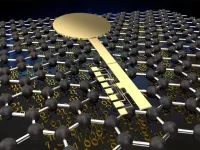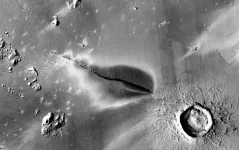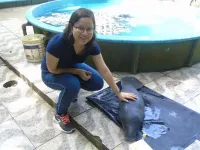(Press-News.org) As more private data is stored and shared digitally, researchers are exploring new ways to protect data against attacks from bad actors. Current silicon technology exploits microscopic differences between computing components to create secure keys, but artificial intelligence (AI) techniques can be used to predict these keys and gain access to data. Now, Penn State researchers have designed a way to make the encrypted keys harder to crack.
Led by Saptarshi Das, assistant professor of engineering science and mechanics, the researchers used graphene -- a layer of carbon one atom thick -- to develop a novel low-power, scalable, reconfigurable hardware security device with significant resilience to AI attacks. They published their findings in Nature Electronics today (May 10).
"There has been more and more breaching of private data recently," Das said. "We developed a new hardware security device that could eventually be implemented to protect these data across industries and sectors."
The device, called a physically unclonable function (PUF), is the first demonstration of a graphene-based PUF, according to the researchers. The physical and electrical properties of graphene, as well as the fabrication process, make the novel PUF more energy-efficient, scalable, and secure against AI attacks that pose a threat to silicon PUFs.
The team first fabricated nearly 2,000 identical graphene transistors, which switch current on and off in a circuit. Despite their structural similarity, the transistors' electrical conductivity varied due to the inherent randomness arising from the production process. While such variation is typically a drawback for electronic devices, it's a desirable quality for a PUF not shared by silicon-based devices.
After the graphene transistors were implemented into PUFs, the researchers modeled their characteristics to create a simulation of 64 million graphene-based PUFs. To test the PUFs' security, Das and his team used machine learning, a method that allows AI to study a system and find new patterns. The researchers trained the AI with the graphene PUF simulation data, testing to see if the AI could use this training to make predictions about the encrypted data and reveal system insecurities.
"Neural networks are very good at developing a model from a huge amount of data, even if humans are unable to," Das said. "We found that AI could not develop a model, and it was not possible for the encryption process to be learned."
This resistance to machine learning attacks makes the PUF more secure because potential hackers could not use breached data to reverse engineer a device for future exploitation, Das said. Even if the key could be predicted, the graphene PUF could generate a new key through a reconfiguration process requiring no additional hardware or replacement of components.
"Normally, once a system's security has been compromised, it is permanently compromised," said Akhil Dodda, an engineering science and mechanics graduate student conducting research under Das's mentorship. "We developed a scheme where such a compromised system could be reconfigured and used again, adding tamper resistance as another security feature."
With these features, as well as the capacity to operate across a wide range of temperatures, the graphene-based PUF could be used in a variety of applications. Further research can open pathways for its use in flexible and printable electronics, household devices and more.
INFORMATION:
Paper co-authors include Dodda, Shiva Subbulakshmi Radhakrishnan, Thomas Schranghamer and Drew Buzzell from Penn State; and Parijat Sengupta from Purdue University. Das is also affiliated with the Penn State Department of Materials Science and Engineering and the Materials Research Institute.
According to the International Whaling Commission, whale-watching tourism generates more than $2.5 billion a year. After the COVID-19 pandemic, this relatively safe outdoor activity is expected to rebound. Two new studies funded by a collaborative initiative between the Smithsonian Tropical Research Institute (STRI) in Panama and Arizona State University (ASU) show how science can contribute to whale watching practices that ensure the conservation and safety of whales and dolphins.
"The Smithsonian's role is to provide scientific advice to policy makers as they pioneer management strategies to promote whale conservation," said STRI marine biologist, Hector Guzmán, whose previous work led the International Maritime Organization to establish ...
Conducting a discussion in a noisy place can be challenging when other conversations and background noises interfere with our ability to focus attention on our conversation partner. How the brain deals with the abundance of sounds in our environments, and prioritizes among them, has been a topic of debate among cognitive neuroscientists for many decades.
Often referred to as the "Cocktail Party Problem", its central question focuses on whether we can absorb information from a few speakers in parallel, or whether we are limited to understanding speech from only one speaker at a time.
One ...
Chemotherapy can induce a painful peripheral neuropathy (CIPN), a chronic condition and common adverse effect for cancer patients undergoing treatment. Researchers at University of California San Diego School of Medicine, with colleagues elsewhere, have used a mouse model to demonstrate the pivotal role of cholesterol in CIPN, and proposed a novel therapeutic approach to reverse it.
The findings are published in the May 10, 2021, online issue of the Journal of Experimental Medicine.
The study was a collaboration between the laboratories of senior study author Yury Miller, MD, PhD, professor of medicine, and Tony Yaksh, PhD, professor of anesthesiology and pharmacology, both at UC San Diego School of Medicine. ...
Evidence of recent volcanic activity on Mars shows that eruptions could have taken place in the past 50,000 years, according to new study by researchers at the University of Arizona's Lunar and Planetary Laboratory and the Planetary Science Institute.
Most volcanism on the Red Planet occurred between 3 and 4 billion years ago, with smaller eruptions in isolated locations continuing perhaps as recently as 3 million years ago. But, until now, there was no evidence to indicate Mars could still be volcanically active.
Using data from satellites orbiting Mars, researchers discovered a previously unknown volcanic ...
All three species of manatee now present on Earth share a common ancestor from which they split some 6.5 million years ago, when a huge lake in Amazonia, then linked to the Caribbean, was cut off from the sea. The African manatee Trichechus senegalensis is not as genetically close to the West Indian manatee T. manatus as was thought, and adaptation to this complex environment by the Amazonian manatee T. inunguis has left at least one mark in its genetic code.
These are key findings of a study supported by FAPESP and published in Scientific Reports, with hitherto unknown details of the evolutionary history of these aquatic mammals. The authors are an international group of scientists led by researchers at the University of Campinas ...
The American College of Chest Physicians® (CHEST) recently released new clinical guidelines on the Diagnosis and Evaluation of Hypersensitivity Pneumonitis (HP). The guidelines contain 14 evidence-based recommendations to improve individual diagnostic decision-making and to decrease diagnostic practice variability.
Occurring at any age, HP is an immunologically mediated form of lung disease resulting from inhalational exposure to a large variety of environmental and/or occupational inciting antigens (typically fungal, bacterial, avian). Over the years, the categorization of HP based on clinical features and disease duration coupled with traditional diagnostic criteria has been unhelpful, even when accurate, when separated from a probabilistic diagnostic ...
Clavelina oblonga, an invasive marine fouling species, not only reduces diversity in communities it invades, it also interferes in their recovery following natural disasters - a process known as "succession."
Succession refers to how an ecosystem recovers after a disturbance or natural disaster - does the system come back more or less the same as it was in terms of species composition, or is it different?
"The classic example of succession is a forest that experiences a wildfire," says Kayla Christianson, former NC State graduate student and first author of a paper describing the research. "As the community recovers from the fire, it proceeds through a predictable pattern of community development - starting with grasses and ending with trees and a mature forest. This ...
Since it debuted in 2011, the Get SET Early program, which provides pediatricians and parents with a relatively simple process to screen for indicators of autism spectrum disorder (ASD) in children as young as age 1, has steadily grown in use and validation. Early screening and identification of ASD has been linked to more effective treatment.
A new study, published in the April 26, 2021 issue of the END ...
PHILADELPHIA-- Human brain organoids are remarkable platforms for modeling features of human brain development and diseases. Building on methods to generate organoids to model different brain regions such as the cortex and the midbrain, researchers at the Perelman School of Medicine at the University of Pennsylvania have generated the first organoids of the arcuate nucleus (ARC), an essential structure in the hypothalamus that sends signals of hunger and feeling full. This part of the hypothalamus exhibits a tremendous amount of cell diversity, and is far more complex than previously modeled parts of the brain.
In a paper ...
Scientists have made major advances in understanding and developing treatments for many cancers by identifying genetic mutations that drive the disease. Now a team led by researchers at Weill Cornell Medicine, NewYork-Presbyterian and the New York Genome Center (NYGC) has developed a machine learning technique for detecting other modifications to DNA that have a similar effect.
The study, published May 10 in Cancer Discovery, a journal of the American Association for Cancer Research, focuses on a type of chemical modification to DNA, called methylation, that typically silences nearby genes. The new technique can analyze the thousands of DNA methylation changes detected in tumor cells and infer which ones are likely ...




